The global Software as a Service (SaaS) market is estimated to reach $908.21 billion by 2030, and is growing at an annual rate of 18.7%. As more companies adopt or build SaaS products for their ongoing business processes or launching innovative ideas, it has emerged as a dominant market player.
Building your SaaS product ideas can be overwhelming, especially if you are undertaking such an project for the first time. Navigating the complexities of SaaS product development involves market analysis, structuring requirements and analysing suitable pricing strategies.
This blog helps you find answers on how to build SaaS products.
While there are various blogs on this topic, often they fail to focus on the bare essentials and do not give a 360 degree view of the process. This article will provide a deep insight into SaaS product development.
What is SaaS?
The term SaaS stands for Software as a Service. This means providing customers with technological applications they can license via a subscription, rather than a one-time purchase of a product that can be downloaded on an individual device. In simple terms, users or customers can access your digital product online by signing in.
A SaaS development agency tailors bespoke applications within a cloud infrastructure and launches them over the internet. So, users can access them via smartphones, desktops, or other devices with a stable internet connection.
What are some examples of SaaS applications?
In our daily life we use a huge amount of SaaS applications we may not even realise; such as Gmail, Microsoft Office 365, Dropbox, Slack and Netflix.
Yes, Netflix is a Software as a Service (SaaS) company!
Subscription-based: Netflix offers a variety of subscription plans, where customers pay a fixed amount to Netflix on a monthly or annual basis.
Cloud-based: Netflix is a cloud-based service, meaning that users can access it from anywhere with an internet connection.
The SaaS Product Development Process
Software as a Service can drive your digital transformation strategy and automate several key processes efficiently. However, before you begin the process, you need to understand critical aspects such as how you can implement SaaS.
SaaS applications are hosted on the following server options:
- Private Cloud
- Public Cloud
- Hybrid Cloud
Once you decide on a suitable Cloud option for your project, it’s time to proceed with the SaaS custom development process.
1. Perform an in-depth market analysis
Deep market research about SaaS product ideas is mandatory for building an innovative and successful solution. You need to conduct meetings with the stakeholders and create well-defined answers for the following:
- What problems will the SaaS product resolve?
- Who will use the products?
- How will you create a unique SaaS product?
The focus here is to determine the viability or the actual product demand.
2. Defining key requirements
SaaS products are designed and built for a giant user-base. It is essential that you carefully plan for privacy regulations and security audits. Early recognition of inconsistencies in the SaaS product helps to streamline this bespoke software development.
















